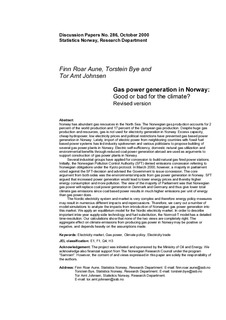| dc.description.abstract | Abstract:
Norway has abundant gas resources in the North Sea. The Norwegian gas production accounts for 2 percent of the world production and 17 percent of the European gas production. Despite huge gas production and resources, gas is not used for electricity generation in Norway. Excess capacity, cheap hydropower, low electricity prices and political restrictions have prevented gas based power generation in Norway. Lately, import of electric power from neighboring countries with fossil fuel based power systems has led industry spokesmen and various politicians to propose building of several gas power plants in Norway. Electric self-sufficiency, domestic natural gas utilization and environmental benefits through reduced coal power generation abroad are used as arguments to support construction of gas power plants in Norway. Several industrial groups have applied for concession to build natural gas fired power stations. Initially, the Norwegian Pollution Control Authority (SFT) denied emissions concession referring to Norwegian obligations under the Kyoto protocol. In March 2000, however, a majority in parliament voted against the SFT-decision and advised the Government to issue concession. The core argument from both sides was the environmental impacts from gas power generation in Norway. SFT argued that increased power generation would lead to lower energy prices and thereby higher energy consumption and more pollution. The view of the majority of Parliament was that Norwegian gas power will replace coal power generation in Denmark and Germany and thus give lower total climate gas emissions since coal based power results in much higher emissions per unit of energy than gas power does. The Nordic electricity system and market is very complex and therefore energy policy measures may result in numerous different impacts and repercussions. Therefore, we carry out a number of model simulations to analyze the impacts from introduction of Norwegian gas power generation into this market. We apply an equilibrium model for the Nordic electricity market. In order to describe important intra-year supply-side technology and fuel substitution, the Normod-T model has a detailed time-resolution. Our calculations show that none of the two views are completely right. The aggregate effect on climate emissions from producing gas power in Norway may be positive or negative, and depends heavily on the assumptions made. | no_NO |
